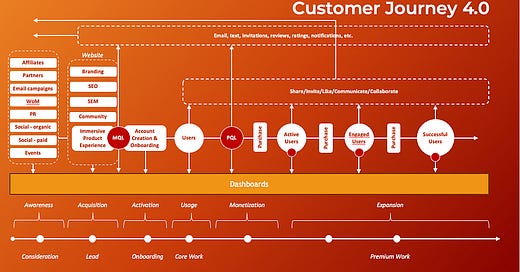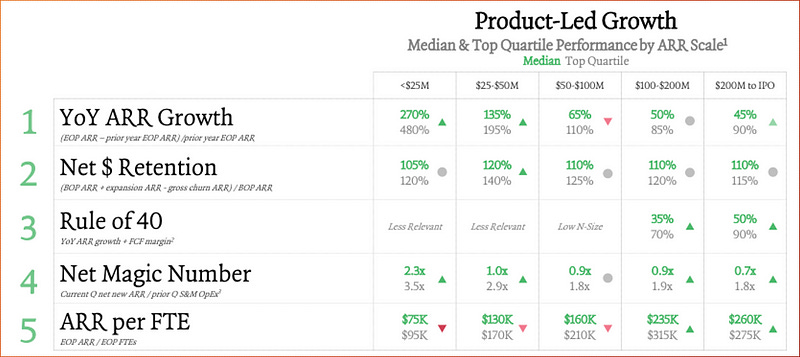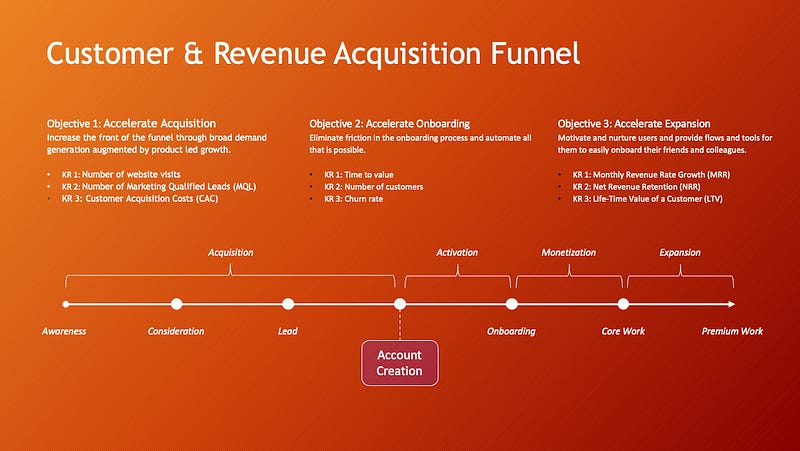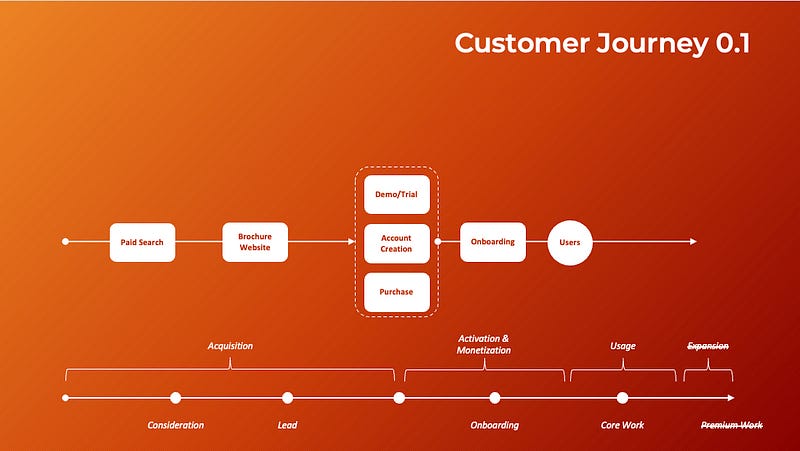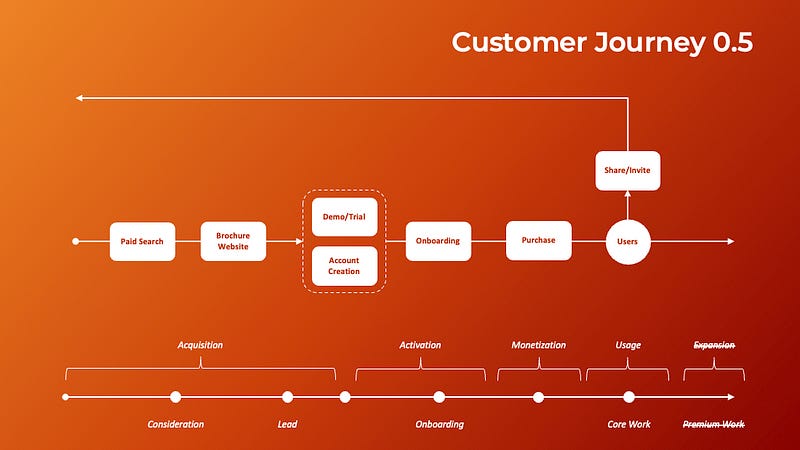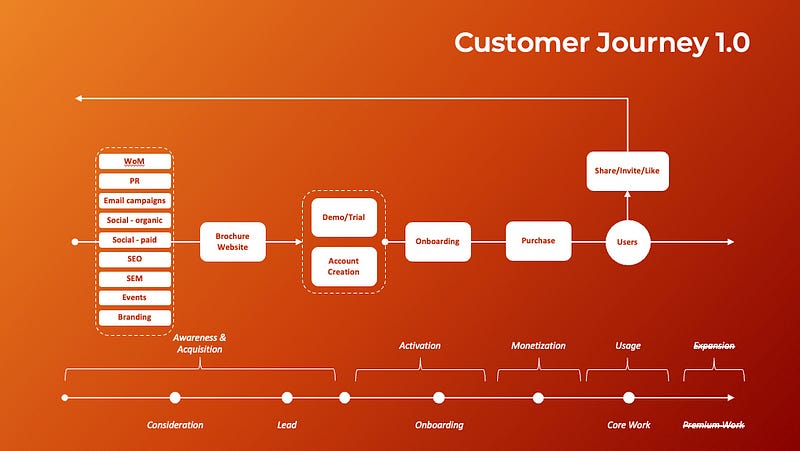10 Steps to Build a PLG Machine from Zero to IPO
What to build at each stage of a Product-Led-Growth company to drive your valuation from zero to over a billion dollars and exit.
How do you build an efficient growth machine and how do you know its impact? What do you build at each stage of the company? When do you invest where?
Especially in 2024, your investors are focused on Net Revenue Retention (NRR). This metric will be a big part of your board meetings. This is how you’ll measure impact and a key measure of how investors will evaluate the business you’re building.
This post tells you what to build at each stage of the company and what metrics you can expect to move.
I’ll walk you through what we did at Outlook Mobile, Slack, and Spendesk to build successful businesses and outsized valuations. All put in the context of the Customer Journey and where you are in your company growth story. From 0-to-1 discovery up to exit.
🎯 The Goal
Before we get started, what is NRR, what does it mean, and how can PDE (see below) drive it?
NRR is the effective sum of all the things your customers and employees are doing and how that activity converts to efficient revenue generation.
Calculated using the below equation and expressed as a percentage, an NRR greater than 100% indicates that your business is growing.
According to surveys conducted by Iconiq Venture Partners, the NRR of a top-performing business will vary depending on the company’s stage. But a good rule of thumb to aim for is 110%-120%. Higher is better.
NRR and the Customer Journey
The challenge is that NRR is a lagging indicator. This means that by the time you know you are wrong it’s too late. It can also be challenging for folks to make the connection between revenue generation and what they should be building this month. Where should the teams focus?
To provide context, below is a generalized version of what we used at Spendesk to articulate the customer journey. For a company with a sizeable PDE (Product, Design, Engineering, Program Operations, Data….there are a lot of folks these three letters include), and with the right weighting, it’s reasonable to create OKRs (Objectives and Key Results) that stretch the entire journey.
Here is where we see the connection between company objectives, unit economics, and where resources can be focused (what to build).
Three key takeaways from this.
You can have the best product in the world, but if you haven’t got an efficient engine to drive Acquisition and Activation, it won’t matter. Growth and efficiency will slow. Customer Acquisition Costs (CAC) will rise and NRR will drop.
You should experiment with when you monetize relative to when the customer is using your product (getting value). In the case of Slack and Outlook Mobile, we prioritized the delivery of value and retention before monetization with a freemium model. This kept CAC very low and enabled us to focus on building valuable features and driving user acquisition, which drove NRR higher.
Expansion can be gaining more users, upselling, and cross-selling. But to get to this, you need to nurture your customers through the entire user journey while you’re building value and expanding your product portfolio.
The building, evolving, and development of the above pipeline is the balance of company, product, and Go-to-market (GTM) transformation for a PLG company. The next sections will walk through each stage of the journey to get to a highly performant, efficient growth machine.
🐣 Zero-to-One: Validate Hypothesis and Build an MVP
This is the most fundamental of starting points. You have a website and a manual onboarding process that separates the customer from the value the product delivers. Those of us who have been in the SaaS business for a while will recognize the Customer Journey of a Seed-Stage startup. A company at the zero-to-one phase of development. However, when was the last time you opened a bank account or got a credit card to then access their online portal or mobile app? The process looked like this, with the additional paperwork and Know Your Customer (KYC) process jammed into onboarding to slow everything down.
Customer acquisition is via paid search and onboarding is highly manual. The website is purely informational and is just a landing page to point prospects towards. Engineering resources are focused on building the core product. The team is engaged closely with customers to carry out qualitative user research and discovery while iterating rapidly toward the first product. This is the AirBnB genesis story.
Key characteristics:
Acquisition, Activation, and Monetization are long
CAC is high
Customer churn is high
Ideal Customer Profile (ICP) is to be determined
NRR is below 100%
Even if you have 5-star reviews, you do not have Product-Market Fit
All available resources are building the core product, so there is no Expansion effort.
Some investors consider success at this stage to be closing a paying customer. This can be a distraction. The value of investing resources to make that sale when the core product is still to be determined is debatable. If you’re going to charge at this stage of the development of the company, then bundle it in with account creation and the onboarding flow as it’s still probably highly manual.
🌱 Seed Stage - Onboard Customers & Build Awareness
Once you have validated the hypothesis central to your product and realized it in code, you’re now ready to start leveraging your existing customers to gain more. You have your Minimum Viable Product (MVP) and you’re ready for your first experiments in flywheel creation.
By enabling existing happy customers to invite or otherwise spread the good news of your MVP via sharing and invitations, you’re doing a few things.
Validating the value of your solution. A share by a user is an implicit NPS score of 10.
Decreasing CAC slightly
Increasing NRR slightly
Ideally, you’d be building a Freemium model, but if you want/need to charge at this stage of the company, put the payment step after you’ve onboarded the user. Payment will be broken out and automated to lower cost-of-sales.
This was the stage the Outlook Mobile team was at when I joined. A small but incredible engineering team with an App Store presence and two simple growth actions.
A link in the footer of every email: Sent from Outlook on iOS/Android
Send availability: A neat workflow to link your calendar and email
The reality is, we’re continually iterating towards achieving Product Market Fit. We’re still working out our personas and narrowing in on the ICP definition. With so many unknowns and changes in the product (inspired by direct user research), we’re not ready to invest deeply into instrumenting the app. Churn will still be high and the only metric of success that is useful at this point will be the number of sign-ups and Monthly/Daily Active Users (MAU/DAU).
🛫 Series A+ Product & Company Launch
While zeroing in on the MVP, ICP and key persona you will be working very closely with Product Marketing (PMM). You need to be building the product while defining how we should be talking about it. Branding, messaging, positioning, etc. All of these will be designed and tested in a tight close loop as you’re building and refining the MVP. Product influences messaging, and messaging influences product.
With these key components in place, you’re now ready to launch your product and your company. This is when you bring on a marketing leader who builds out the marketing component of the company. This often involves a lot of outsourcing and consultants, but you need leadership and PMM in-house working closely with Product and Design.
Keep reading with a 7-day free trial
Subscribe to Beyond the Build to keep reading this post and get 7 days of free access to the full post archives.


